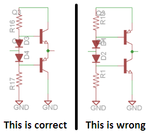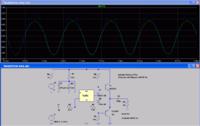Plecto
Full Member level 5

The output above half supply seems to be lower than below half supply. Are both channels showing the same distortion? You have the output transistor connected differently from one channel to the other.
I just noticed that. That is an error in the schematic, but not on the finished board. Both channels are showing the same distortion. If I scope the point before the output capacitor, the sine wave is clearly centered around 4.5V. The op-amp clearly has some issue when sinking current, but not when sourcing it I think
The original Cmoy headphones amp used newer and better opamps and used an 18V supply with a Mickey Mouse virtual ground circuit.
Why are you using older opamps and only ONE 9V battery?
What is a "bias capacitor"?
Maybe one or both of your 9V batteries is/are dead.
Please post your detailed schematic.
It has been pointed out several times that NE5532 is a bad idea for a cmoy amplifier (I don't know why though). I looked at some forum where someone had tested a NE5532 so I bought one and tested for myself and was quite happy with it. I then bought 100pcs of them. This was a little over a year a go, I wouldn't have done the same today.
I'm using only one 9V battery to save space. There is no way a simple op-amp can output +-8V or so into 30-60Ohms anyway so I don't see the point of having a supply that huge (other than to avoid some distortions perhaps).
I was talking about the voltage divider capacitor for the non-inverting input (to avoid power supply ripple from entering the amplifier)
The battery is not dead
I posted a schematic above, what details are missing? https://obrazki.elektroda.pl/9993570300_1378587719.jpg
edit: I did some further scoping. The distortion is present regardless of frequency and output voltage levels. This makes me think that it has something to do with the output current of the op-amp, but the distortion is gone if I disconnect the headset and only leave the 1k Ohm output cap charge resistors as loads :S Replacing the bjt's with fet's made no difference.
Last edited:



